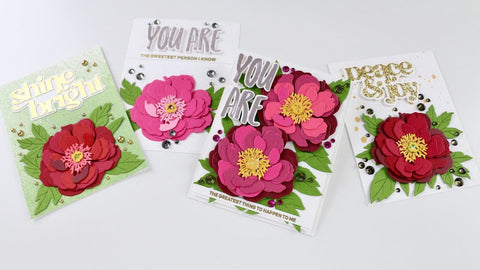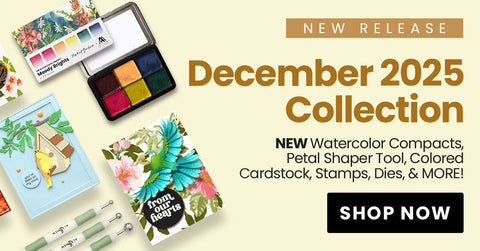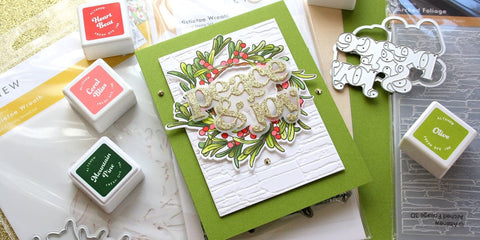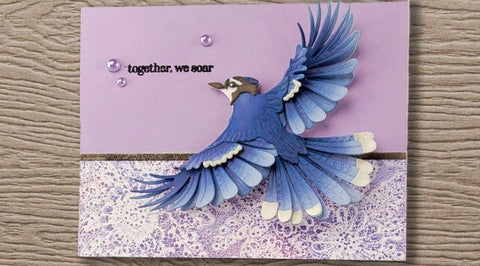How to Use Watercolor Markers in Paper Crafting
Last Updated: August 29, 2025
Watercolor markers are an easy way to add color and detail to any paper crafting project. The secret is in the nibs! If you're just getting started with this coloring medium or if you've been using it a while and need a refresher course, then keep reading! We’re answering your burning questions about these must-have watercoloring tools.

Smiles and Hugs Stamp & Die Bundle
A Brief History of Watercolors
Watercolor is often called an unforgiving medium; however, it is also versatile and distinctive. It blurs the line between painting and drawing. Its flowy and water-based properties make it ideal for simple and freehand artwork as well.
Watercolor was believed to have originated more than seven centuries ago in England. It has revolutionized art around the world with its rich and successful history. However, it didn't reach its artistic heights until the 1800s, when watercolor artists started using this medium for sketches and informal projects.
The artist who pioneered watercolor painting was Albrecht Durer. The impressive details and stunning color contrasts of his paintings were incredible. Known for his Renaissance art, he was also one of the first landscape painters in Europe. Aside from Durer, other notable early watercolor artists include Van Dyck, Giovanni Benedetto, and Claude Lorrain.

Altenew Watercolor Painting Supplies
What Are Watercolor Markers?
Watercolor markers have a wide range of properties, making them perfect for all your watercoloring needs. They can go from intense pigment to lovely pale shades (when diluted). Unlike watercolor pans or tubes, watercolor pens give you the best of both worlds - without the mess. You have the pigment and the brush in one convenient tool! You can use it for watercoloring and calligraphy. While other artists would still opt for another paintbrush and a palette, the great thing about these markers is you can simply use them as-is - no extra tools needed.

There’s a ton of different brands of watercolor brush pens in the market today. Their usage, sizes, and features vary. Here are some common features:
- Juicy and vibrant
- Flexible
- Non-toxic
- Acid-free
- Water-soluble
- Dye-based
- It goes on smoothly on watercolor paper.
- Some have felt tips or soft brush tips.
- Some have soft bristle tips.
- Some are refillable.
- Some might have a runny or very fluid consistency.
- Some are dual-tipped.
- Some have a long and thin body.
- Some have a chunky and angular body.
- Some brush nibs tend to get frayed easily.
- Some have long and soft bristle tips, making it challenging to use in calligraphy or lettering.
- Some come with a travel case or carrying case.
- Some need to be activated with water; others already have water in them.
Are you curious about the different types of watercolors for paper crafting? Watch the Watercolor Showdown video below to learn more!
Altenew’s Watercolor Brush Markers feature barrels filled with water-based pigment. Each color coordinates with our line of inks. The flexible yet sturdy bristles on the brush tip allow you to form both broad and fine strokes. The best thing about these watercolor markers? Color can be applied straight from the marker or diluted with water for a softer look.

Tropical Fiesta Watercolor Brush Markers & Refill Bundle
How Do You Use Watercolor Markers?
Are you having trouble using watercolor markers? Do you need more fresh ideas and techniques? We’re sharing a few tips, tricks, and hacks to help you get started on your watercoloring journey.
But first, here are a few tips to remember before you begin!
- Make sure that your crafting space is ready for watercoloring and clutter-free. You don’t want to work on a dirty, messy, or cluttered surface.
- Use a crafting mat or oven liners to avoid getting watercolors on your table and other tools.
- Prepare a clean cup of water or a spray bottle filled with clean water.
- Feel free to prepare other paintbrushes if you have them.
- Always have some baby wipes, paper towels, or clean cloth handy. You might make a mess, so it’s better to be prepared.
- You might need a clean microfiber towel to clean your paintbrush after using it.
- Work in a room with good lighting and airflow.
- Always place the lid back after using your watercolor pens. You don’t want them to dry out.

Tropical Fiesta Essentials Bundle
Using watercolor markers for the first time? Follow these 5 easy steps:
- Depending on the type or brand of marker you’re using, you can scribble some of it onto a palette or directly press the tip onto the watercolor paper.
- You can either pick up the pigment from the palette using a clean, wet paintbrush or use the wet paintbrush to spread the pigment around the paper.
- If you want a vibrant color payoff, then there’s only a little blending needed using your paintbrush.
- If you are going for a more soft and diluted look, feel free to add more water to the pigment.
- Keep on moving around the pigment and trying out various techniques such as shading, blending, layering, blotting, etc.
Watch the watercolor brush markers tutorial below to learn three different ways to use this incredible tool!
How to Shade With Markers?
To produce lighter shades with your watercolor brush pens, dip your paintbrush into clean water before picking up some pigment from the brush pens. Adding some water directly or indirectly onto the pigment will dilute it, therefore producing lighter shades.
You may use the same paintbrush or use a blending brush (this is a brush filled with water and glycerin) to help you do some shading on your artwork.

Altenew Watercolor Brush Markers
Do You Dip Watercolor Markers in Water?
You can dip watercolor markers in clean water, but it’s not required. Dipping the tip of the marker in water will dilute the color, making it lighter. This is a good technique if you want to achieve beautiful watercolor washes and other watercolor effects. If you want to have more control over the color, you can simply squeeze out some paint onto a palette and dilute it with water. Just remember, the longer you dip, the lighter the color.

Watercolor Marker Ultimate Bundle
We hope you've enjoyed learning about using watercolor markers and what they can do for your paper crafting projects. As a beginner, these markers are the perfect tool for you! They're easy to use, juicy, and vibrant. With many different colors available -- they make your coloring projects come alive in color. Plus, this is an affordable option that's great for paper crafting projects like card making or scrapbooking because it combines a few essential tools into one package.
If you're looking for a new craft to try, or if it's time to start adding some color to your life, we recommend giving watercolor markers a shot! Interested in using these handy tools? Read on for tips and tricks from our expert designers, who can help you explore how to get started with watercolor pens today!















